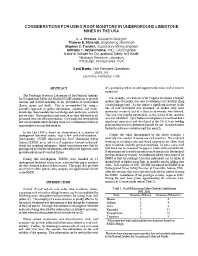Mining Publication: Considerations for Using Roof Monitors in Underground Limestone Mines in the USA
Original creation date: August 2003
The Pittsburgh Research Laboratory of the National Institute for Occupational Safety and Health (NIOSH) endeavors to provide national and world leadership in the prevention of work-related illness, injury, and death. This is accomplished by using a scientific approach to gather information, assemble and create knowledge, then translate the knowledge and results into products and services. These products and services are then delivered to all personnel who can effect prevention. Obviously, the development and use of instruments to monitor mine roof conditions provides an opportunity to execute that mission. In the late 1990s, based on observations at a number of underground limestone mines, only a few used roof monitors. Subsequently, NIOSH introduced the Roof Monitoring Safety System (RMSS) as an aid to roof inspection beyond traditional visual and sounding techniques. Initial expectations were that by gaining roof movement information, ultimately roof sag rates could provide indications of eventual failure. During this investigation, RMSSs were installed in 13 underground limestone mines in 6 states; this paper analyzes the data obtained at 3 of these mines. This paper also provides an overview of the system, data, analysis, and applications relevant to the RMSS.
Authors: LJ Prosser, TE Marshall, SC Tadolini, AT Iannacchione, C Banta
Conference Paper - August 2003
NIOSHTIC2 Number: 20023434
Peng SS, Mark C, Khair AW, Heasley KA, eds. Proceedings of the 22nd International Conference on Ground Control in Mining ,August 5-7, 2003, Morgantown, WV: West Virginia University, 2003; :119-126
See Also
- Effects of Stimulation Treatments on Coalbeds and Surrounding Strata: Evidence from Underground Observations
- Evaluation of Support and Ground Response as Longwall Face Advances into and Widens Pre-Driven Recovery Room
- Field Observations and Numerical Studies of Horizontal Stress Effects on Roof Stability in U.S. Limestone Mines
- In Situ Estimation of Roof Rock Strength using Sonic Logging
- Mapping Hazards with Microseismic Technology to Anticipate Roof Falls - A Case Study
- Neural Network Technology for Strata Strength Characterization
- New Developments with the Coal Mine Roof Rating
- Roof Span Design for Underground Stone Mines
- A Spatial/Spectral Domain Microwave Coal Seam Imaging Sensor-Progress in Signal Processing
- Technology News 481 - Update: Roof Monitoring Safety System for Underground Stone Mines
- Page last reviewed: 9/21/2012
- Page last updated: 9/21/2012
- Content source: National Institute for Occupational Safety and Health, Mining Program


 ShareCompartir
ShareCompartir
